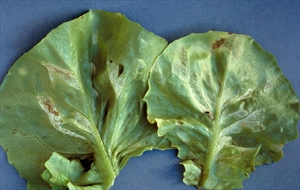Lettuce downy mildew
Pacific Pests, Pathogens and Weeds - Online edition
Pacific Pests, Pathogens & Weeds
Lettuce downy mildew (209)
Bremia lactucae; there are several strains of the oomycete.
Asia, Africa, North, South and Central America, the Caribbean, Europe, Oceania. It is recorded from Australia, New Caledonia, and New Zealand.
Lettuce and relatives, including globe artichoke, endive, chicory and ornamental and wild species in the daisy or sunflower (Asteraceae) family. The weeds, groundsel, (Senecio), sowthistle (Sonchus), and dandelion (Taraxacum) are wild hosts.
The disease is caused by an oomycete or water mould, not a fungus. Although downy mildews look like fungi, they are related to algae.
Light green to yellow, round to angular spots on the top of the leaf, merging and later turning brown, and sometimes becoming soft and slimy (Photo 1). On the lower side of the leaf, a white growth develops and this contains the spore masses that develop under cool and humid conditions (Photos 2&3). Thick-walled resting spores called 'oospores' are formed, but their importance in the life cycle of lettuce downy mildew is uncertain.
Spread of the downy mildew is by spores; these are produced at night and in the morning released from their spore-bearing stalks and blown in the wind to plants nearby and over long distances. The spores do not live for long; for successful infection, leaves need to be wet for 3-4 hours.
Survival can occur as oospores in the soil and on weeds, but often it is by the transfer of spores from older to younger crops.
Lettuce downy mildew is an important disease capable of causing the rapid destruction of the plant. Damaged plants may require trimming at harvest, and they are susceptible to secondary rots in transport and storage.
Look for the yellowish angular spots on the top of the older leaves, and white fungal-like growth on the underside. Look for spots that turn brown as they age.
QUARANTINE
As this disease is not recorded in many countries, biosecurity authorities should consider the potential pathways for entry.
CULTURAL CONTROL
Before planting:
- Keep nurseries free from weeds, especially those in the daisy or sunflower family.
- Avoid overcrowding seedlings. Make sure that there is sufficient air movement around them to dry leaves rapidly after watering or rain.
- Carefully check each seedling before transplanting in the field, and remove any that show downy mildew symptoms. If symptoms are seen, spray all the seedlings with a systemic fungicide.
During growth:
- Space plants so that air can circulate around them; this helps to dry the leaves rapidly after irrigation or rain.
- Preferably, avoid overhead irrigation, especially during cool times. It is important that the foliage does not stay wet overnight, as this is the time that downy mildews produce their spores.
- Control weeds. Weeds can be a source of downy mildew, and also increase the humidity around the crop so that leaves stay wet longer. The longer leaves stay wet the greater the chance of spore germination and infection.
- Monitor plants for the first infections, and spray if weather is cool (less than 23°C) and damp (humidity more than 85%).
After harvest:
- Collect plant remains, remove and burn or dig them deeply into the soil.
- Do not plant lettuce in the same land if the crop was diseased; leave a gap of 2-3 years. Oospores - the resistant spores - can survive in the soil.
- Avoid planting overlapping crops of lettuce if downy mildew outbreaks occur. It is common for older crops to infect younger ones.
RESISTANT VARIETIES
Varieties with resistance to downy mildew exist, but there are several strains.
CHEMICAL CONTROL
Use fungicides that are recommended for Pythium and Phytophthora. Spray with systemic products, e.g., (i) metalaxyl (mixed with mancozeb or as alternating sprays to prevent build-up of resistance to metalaxyl) or (ii) fosetyl-Al; or use protectant products, e.g., mancozeb, copper or chlorothalonil. To increase effect of fungicides, keep humidity and leaf wetness as low as possible (see above).
____________________
When using a pesticide (even a biopesticide), always wear protective clothing and follow the instructions on the product label, such as dosage, timing of application, and pre-harvest interval. Recommendations will vary with the crop and system of cultivation. Expert advice on the most appropriate pesticide to use should always be sought from local agricultural authorities.
AUTHOR Grahame Jackson
Information (and Photo 1) from Diseases of vegetable crops in Australia (2010). Editors, Denis Persley, et al. CSIRO Publishing; and from CABI (2014) Bremia lactucae (downy mildew of lettuce). Crop Protection Compendium. (https://www.cabi.org/cpc/datasheet/9937/); and from Scheufele S (undated) Lettuce, Septoria blight. The Center for Agriculture, Food, and the Environment. University of Massachusetts Amherst. (https://ag.umass.edu/vegetable/fact-sheets/lettuce-septoria-blight). Photos 2&3 Kohler F, et al. (1997) Diseases of cultivated crops in Pacific Island countries. South Pacific Commission. Pirie Printers Pty Limited, Canberra, Australia.
Produced with support from the Australian Centre for International Agricultural Research under project PC/2010/090: Strengthening integrated crop management research in the Pacific Islands in support of sustainable intensification of high-value crop production, implemented by the University of Queensland and the Secretariat of the Pacific Community.






